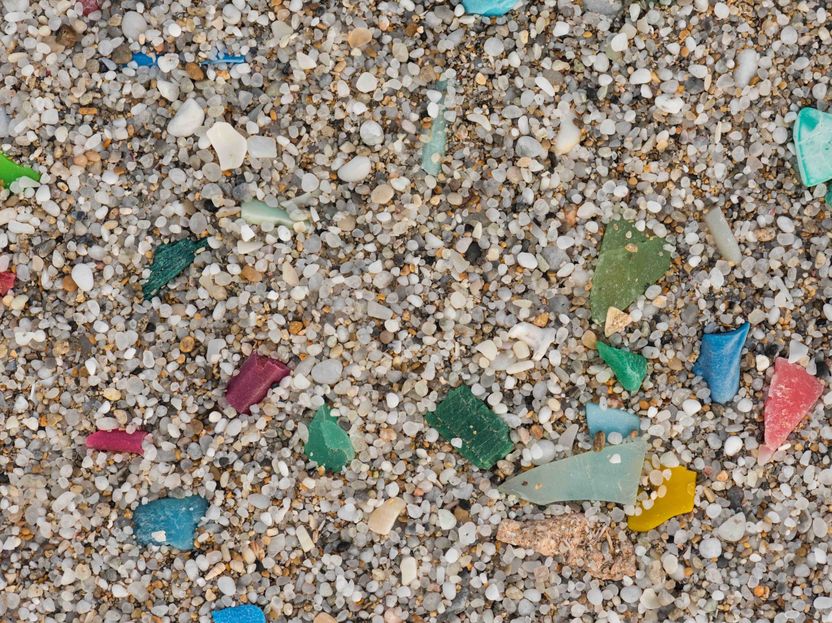Microplastics in freshwaters
The risks to the environment are (still) low
Advertisement
Sea birds dying in agony with a belly full of plastic garbage; plastic accumulations as big as islands: Virtually everyone has seen pictures like these today. But there are also plastic particles that are barely visible to the eye - microplastics. The danger posed by these tiny particles has hardly been researched to date. Empa researchers have now carried out the world's first risk assessment for microplastics in lakes and rivers. The study concludes that aquatic organisms in Europe are not (yet) acutely endangered.

According to various researchers, there is practically no plastic-free place in the world anymore.
Bernd Nowack / Empa
As small as a grain of dust - but of great global significance. The word microplastics is familiar to many, but the dangers are virtually unexplored. In recent years, plastic pollution has become an ever-increasing burden on the environment. Countless videos and media reports draw attention to this problem. While the dangers of large plastic pieces for animals are impossible to overlook, there is practically nothing about the dangers posed by microplastics. But what is microplastics anyway?
Phenomenon Microplastics
Microplastics include plastic particles that are smaller than five millimeters. There are two types of microplastics: (i) plastic granules, which are used as starting material for the production of various plastic products, but also for cosmetics and household articles (primary microplastics) and (ii) plastic fragments, which are produced in the environment during the decomposition of larger plastic parts, e.g. due to weathering or mechanical stress (secondary microplastics). An important source of secondary microplastics are fibre fragments which are released into the waste water during the washing of synthetic textiles. Primary microplastics are discharged into waste water through cleaning processes, for example in industrial plants, house cleaning or showering. Although not designed for this purpose, wastewater treatment plants are quite efficient at filtering microplastics out of wastewater. Nevertheless, large quantities of microplastics are distributed in water and soil all over the world - and the trend is upwards.
No danger for Europe
Can these tiny particles be a problem for the environment? The environmental scientist and Empa researcher Bernd Nowack is investigating the environmental impact of microplastics. Together with Véronique Adam, Nowack has now carried out the world's first risk assessment for freshwater fish and other aquatic organisms. The researchers have compared and evaluated the results of countless studies. In order to find out whether there is a risk to the environment, they applied a method established for the assessment of environmental risks from chemicals. The researchers compared real measured water pollution by microplastics with threshold values for possible toxic effects in different organisms. If the pressures and thresholds overlap, there is a real environmental risk.
Result: In Europe, there is currently no danger to the environment, as the concentrations of microplastics actually measured in the waters studied to date are well below the threshold values. However, it is well known that Asia is particularly affected by the plastic problem. Nowack and Adam also found an overlap in the data from Asia between the pressures and the threshold values, even if this is extremely small.
Sewage treatment plants for protection
As these two examples show, the researchers found differences between the different regions of the world in terms of pollution from microplastics and the resulting risk to the environment. Especially in regions with no or only a limited functioning wastewater treatment system, higher environmental concentrations can occur. This is because well-functioning wastewater treatment plants are particularly important for "protecting" the environment from microplastics.
Nowack's conclusion: "There is currently no evidence that microplastics pose a risk to the environment in Europe." However, further investigations are necessary to be able to definitively rule out negative consequences, as the overall data basis is still quite sparse, especially with regard to local hotspots of microplastics in the environment. For example, Nowack recommends controlled studies with standard methods and complete characterisation of the particles. His own research group "Environmental Risk Assessment and Management" in Empa's "Technology and Society" department in St. Gallen will certainly pursue the topic further. Similar risk assessments for microplastics in soils and a study for the oceans are planned. Current research projects also include quantifying microplastic flows into the environment and investigating the formation of microplastics during washing and weathering.


















































